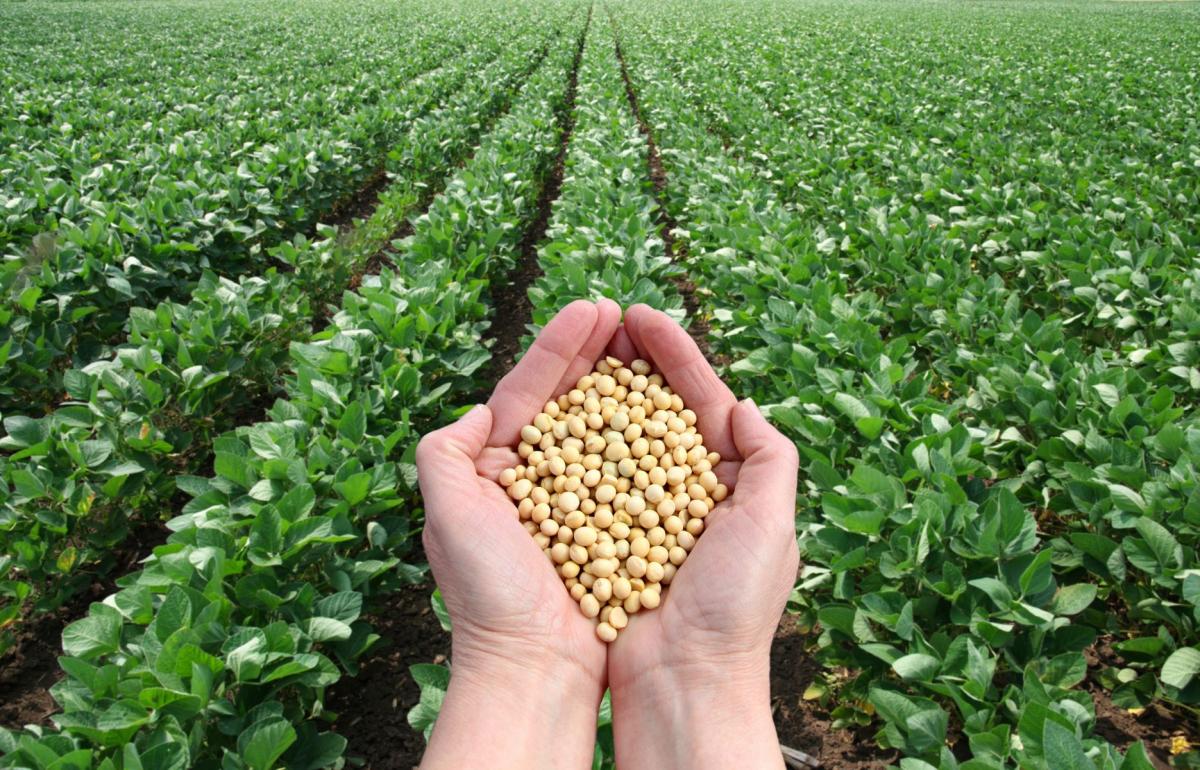Insects: Bean Leaf Beetle and Mites
Bean Leaf Beetle
The bean leaf beetle (Cerotoma trifurcata) is a small beetle (at least 1⁄4 inch in length) with the adult’s coloration from red, orange, tan or gray, and markings (dots, strips or both) may vary among individuals or populations. However, even with the variation in color and marking, all adults possess a black triangle at the base of their forewings (Figure 1). This insect overwinters as adults beneath leaf litter in wood lots, weeds or alfalfa fields adjacent to soybean fields. Once spring temperatures reach 50°F to 55°F, adults become active and seek available hosts plants (such as grasses, soybean plants and other legumes) to feed. Early season damage due to bean leaf beetle is found in early planted soybeans. The adults feed on the cotyledons, stems, unifoliate leaves and emerging trifoliate leaves. Stand losses are possible in soybeans when feeding occurs at this growth stage.
Adults mate and lay eggs in the soil adjacent to the plant’s stem. The hatching larvae feed on soybean roots with little impact on soybean development.
Larvae may feed for three to six week before pupating. Adults emerge approximately one week later to feed, mate and lay eggs. In Nebraska, one to two in‐season generations are observed. First and second generation beetles chew small, round holes in soybean leaves during mid- and late season. As the foliage matures, the beetles are less attracted to feed on this tissue and instead start to feed on the green tissue of pods, leaving a thin membrane over the seed. When thepods being to mature, the membrane often cracks, leaving an entry hole for air born plant pathogens. These pathogen may cause discolored, moldy, shriveled and/or diseased beans.
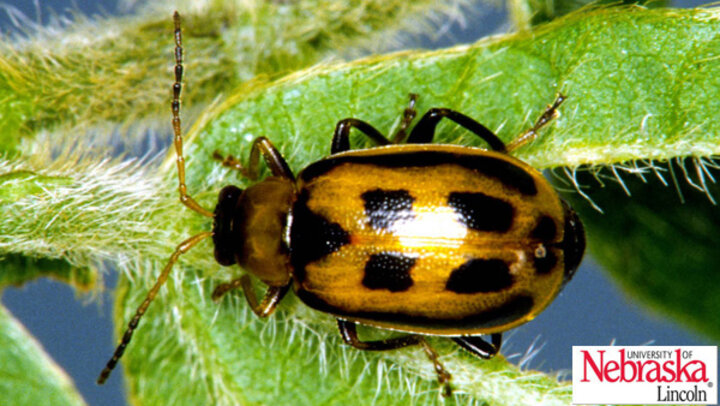
Bean Leaf Beetle Management
Seed Treatment Insecticides
Seed treatment insecticides have been shown to reduce early season bean leaf beetle feeding. These treatments are usually warranted when growers plant some of the earliest soybeans in an area and may expect seedling stage feeding damage.
Scouting
As soon soybeans emerge, it is important to scout fields weekly for bean beetle infestations. Direct observation along with stand counts can be used early in the season. By mid-season, either sweep nets or drop clothes are effective sampling tools. Adult bean leaf beetles are shy and when disturbed will group to the ground or onto lower leaves. When using a sweep net, adults are typically found in the bottom of the net hiding underneath leaves or within the folds of the net. In late season field scouting, counts of adults and the number of damaged pods is important when determining if an infestation has exceeded the economic threshold.
Insecticides
Insecticide applications can be effective in managing adult bean leaf beetle populations. Using the appropriate economic threshold at the different soybean growth stages is critical (Table 2 and 3).
| Crop Value | $6 | $7 | $8 | $12 |
|---|---|---|---|---|
| $8 | 2 | 2 | 3 | 4 |
| $9 | 2 | 2 | 3 | 3 |
| $10 | 1 | 2 | 2 | 3 |
| $11 | 1 | 2 | 2 | 2 |
| $12 | 1 | 1 | 2 | 2 |
Table 1: Economic threshold for treating bean leaf beetles in soybean at the VC growth stage (number of beetles per plant) Source: https://cropwatch.unl.edu/scout-early-emerging-soybeans-bean-leaf-beetles
| Crop Value | $6 | $7 | $8 | $12 |
|---|---|---|---|---|
| $8 | 3 | 3 | 4 | 5 |
| $9 | 2 | 3 | 4 | 4 |
| $10 | 2 | 3 | 3 | 4 |
| $11 | 2 | 2 | 3 | 4 |
| $12 | 2 | 2 | 3 | 3 |
Table 2. Economic threshold for treating bean leaf beetles in soybean at the V1 growth stage (number of beetles per plant). Source: https://cropwatch.unl.edu/scout-early-emerging-soybeans-bean-leaf-beetles
Two‐Spotted Spider Mites
Two‐spotted spider mites are very small arachnids (<0.002 inch in length) that are greenish, yellow to orange in color with two dark spots on their abdomen (Figure 45). This pest is considered an arachnid because it has eight legs instead of six, which is characteristic of insects. Mites are able to attack a wide range of hosts including soybeans, dry beans, alfalfa, corn, vegetables and trees. They survive the winter months as eggs and move to crops upon hatching in the spring. Mites colonize the underside of leaves. A common characteristic of spider mite infestation is the presence of “webbing” (Figure 2). The webbing is silk thread it makes to line feeding areas and are also used to assist it in dispersal by the wind.
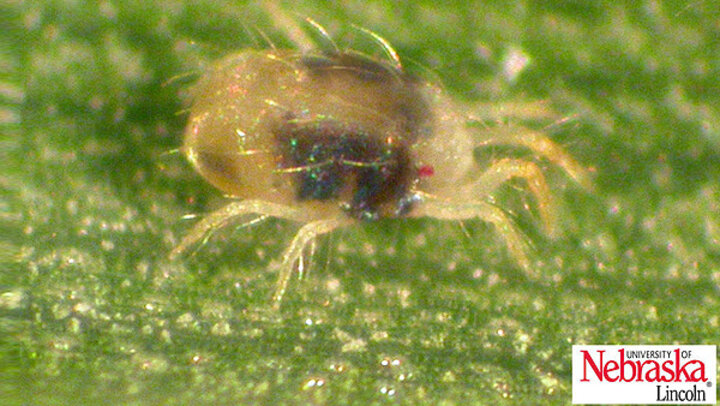
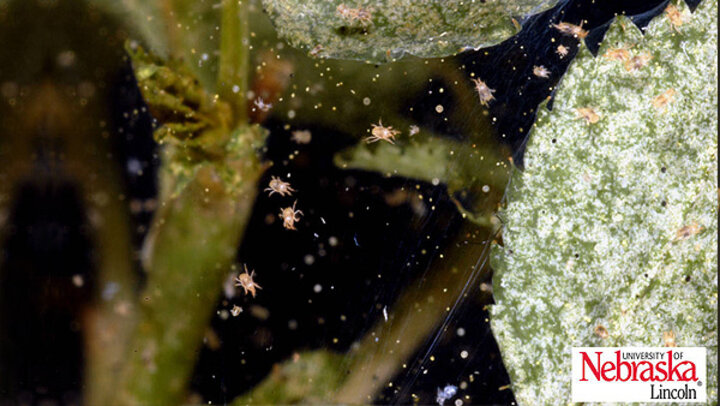
The life cycle of spider mites is very straightforward, progressing through three stages between egg and adult. Depending on the temperature, development takes between five to 19 days.
Reproduction occurs much faster when temperatures >90°F, while cooler temperatures slow reproduction down. When reproduction is optimal, a female can produce up to 100 eggs each, which explains why populations can increase 70 times in as little as six to 10 days.
Spider mite damage is more prevalent during drought conditions. With piercing sucking mouthparts, the injury observed is white or yellow spots or “stippling” that is heaviest on the underside of leaves (Figure 4). This injury causes a reduction in photosynthesis and increase water loss to the plant. Large spider mite colonies can cause the entire leave to turn grayish green to yellow, brown or coppery and then drop off. Damage is first observed in the lower canopy and progresses upward.
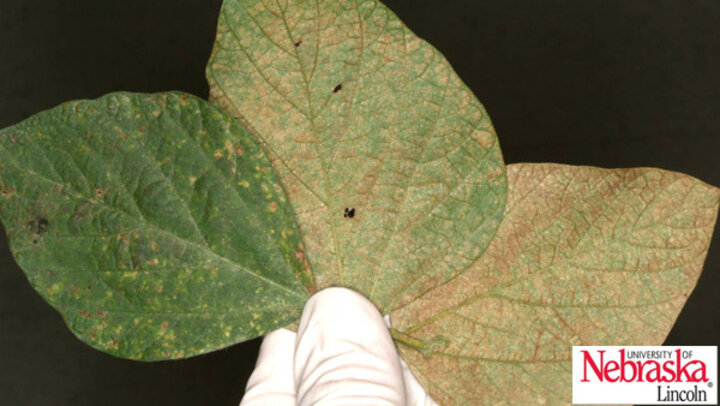
Two-Spotted Spider Mite Management
Scouting
Examine plants at the field edge first, especially adjacent to roadsides, drainage ditches or alfalfa. Pull plants and examine the leaves from the bottom upward. Look at the underside of leaves for stippling and webbing. Examine leaves for mites with a hand lens or tap infested leaves over a white sheet of paper and determine how far mites and symptoms have progressed up the plant. If mites are present, move further into the field at least 100 feet and continue with assessment. Walk a “U” pattern in the field checking at least two plants at each of 20 locations. Check fields every four to five days when drought persists.
Miticides
An application of a miticide would be warranted in a soybean field that has a spider mite population that exceed the economic threshold. Full Pod (R4) and Beginning Seed (R5) stages are critical in determining soybean yield. Only a 10‐15% reduction in effective leaf area will have yield losses and justify an insecticide/miticide application. Careful selection of a control product is critical. There are several insecticides labeled for soybeans but only a few are efficient in managing spider mites.
Insecticide
When an aphid population has exceeded the economic threshold, an insecticide application may be applied.

Nebraska Soybean Board graciously provided the funding for the Soybean Management Guide.
Course authored by:
Amy Timmerman, extension educator; Aaron Nygren, extension educator; Brandy VanDeWalle, extension educator; Loren Giesler, Plant Pathologist Department head; Ron Seymour, extension educator; Keith Glewen, former extension educator; Charles Shapiro, emeritus extension soil scientist; Amit Jhala, extension weed specialist; Don Treptow, former graduate student
